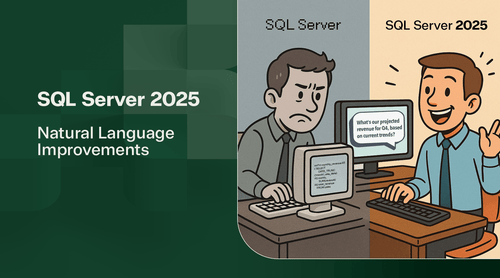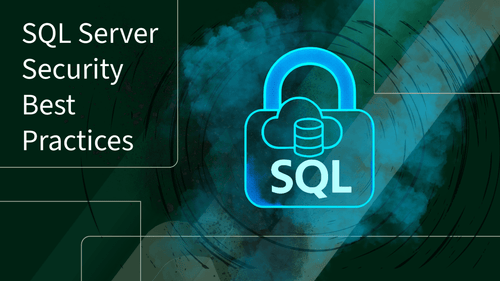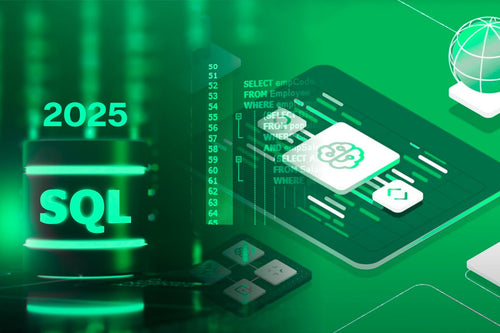The release of SQL Server 2025 marks one of the most significant leaps forward in the history of Microsoft’s flagship database platform. At the heart of this evolution is artificial intelligence (AI), bringing natural language, semantic search, and retrieval-augmented generation (RAG) directly into your SQL environment. Until now, database searches have relied on exact keyword matches. While functional, this approach often fails to capture the context let alone the nuance of human language. Any variation, synonym, or shift in phrasing could leave users empty-handed, making the most significant challenge simply finding the data they need.
SQL Server 2025 bridges the gap between how people think and query and how traditional databases operate. With new AI-powered features like AI Generate Embeddings and AI Generate Chunks, SQL can now understand meaning, context, and intent, transforming raw text into vectorized representations of thought. This enables semantic search that goes far beyond literal matches. The result is more innovative applications, more relevant insights, and a new level of business value driven by natural interaction with relational data.

Semantic Search: Searching by Meaning, Not Just Keywords
Traditional SQL queries are great at finding exact matches but struggle when users don’t know the precise keywords to type. Semantic search in SQL Server 2025 addresses this issue by enabling searches that consider context, synonyms, and intent.
This shift from keyword-based to meaning-based search unlocks powerful new capabilities, including:
- Improved product discovery. Users find what they need even if they don’t know the exact name.
- Smarter customer support: Support teams can surface relevant tickets or documentation based on conceptual similarity, not just matching phrases.
- Enhanced analytics: Businesses can analyze feedback, reviews, or logs with greater nuance, identifying trends and sentiments that traditional search would miss.
The AI language features can understand the query and look for semantically related terms beyond the old exact match look-up.
Here are a few examples of how AI-powered SQL 2025 opens the door to customer support analysis, product matching in e-commerce, and document review and retrieval.
Product Discovery in E-Commerce
Query: “eco-friendly kitchen tools”
Traditional Search: Matches only items labeled “eco-friendly kitchen tools.”
Semantic Search: Includes products described as “biodegradable spatulas,” “recycled cutting boards,” or “sustainable cookware,” even if “eco-friendly” isn’t explicitly mentioned.
Impact: Improves product recommendations and conversion rates by aligning with user intent.
Legal Document Review
Query: “termination clauses for contractors”
Traditional Search: Finds documents with the exact phrase “termination clauses.”
Semantic Search: Retrieves content discussing “contract dissolution,” “early exit terms,” or “freelancer disengagement policies.”
Impact: Speeds up legal reviews by surfacing relevant content across varied terminology.
Legal Document Discovery
Plain Search Term: “contract termination”
Semantic Search Result: Returns documents discussing “breach of agreement,” “cancellation clauses,” or “early exit provisions.”
Why It Matters: Lawyers can uncover related legal precedents or clauses that match the intent of ending a contract, even if the exact phrase isn’t used.
Medical Records Search
Plain Search Term: “heart attack”
Semantic Search Result: Includes documents mentioning “myocardial infarction,” “cardiac arrest,” or “acute coronary syndrome.”
Why It Matters: Clinicians or researchers can retrieve relevant patient records or studies even if the terminology differs, improving diagnostic insights and treatment planning.

Retrieval-Augmented Generation (RAG) Inside SQL
One of the most powerful AI trends, retrieval-augmented generation (RAG), is now built into SQL Server 2025.
RAG combines two strengths:
- Large language models (LLMs): can interpret natural questions and generate responses.
- Your trusted database: Which provides accurate, up-to-date, and secure data.
Instead of relying only on an AI model’s memory, SQL Server can now pull relevant facts from your database in real time, ensuring useful and trustworthy responses without exposing sensitive information to external systems.
Why it matters:
- Accuracy: Answers are based on your actual data, not just model memory.
- Security: Sensitive data stays inside your environment.
- Contextual Intelligence: Responses reflect your business logic, terminology, and current state.
Here are a few expanded examples showing how Retrieval-Augmented Generation (RAG) inside SQL Server 2025 transforms AI-powered workflows by combining large language models (LLMs) with real-time, secure database access:
Real-Time Inventory Insights for Customer Service
Scenario: A support agent asks, “Do we have any refurbished Surface Pros available for overnight shipping?”
Traditional AI: Might respond with general product availability or outdated stock info.
RAG in SQL Server 2025: The LLM understands the intent (refurbished + fast shipping), queries the live inventory table, filters by condition and shipping eligibility, and returns a confident answer.
Benefit: Enables real-time, intent-aware responses that improve customer satisfaction and reduce manual lookups. Contextual
Sales Forecasting Assistant
User Query: “What’s our projected revenue for Q4 based on current trends?”
RAG Response: The LLM interprets the question, then queries your sales table, applies current growth rates, and returns: “Based on current sales velocity and historical Q4 performance, projected revenue is $4.2M, a 12% increase over last year.”
Why It’s Powerful: Combines natural language understanding with real-time data and business logic—no need to write complex SQL manually.
Inventory Management Insights
User Query: “Do we have enough stock to fulfill the new West Coast order?”
RAG Response: The model checks inventory levels, recent shipments, and order details, then replies: “Yes, we have 1,200 units in the LA warehouse. The West Coast order requires 950 units, so fulfillment is possible without delay.”
Why It’s Powerful: Combines intent recognition with real-time operational data to support fast decision-making.

External Models: Bringing AI Into Your Database
SQL Server 2025 introduces external models, allowing you to connect your database to AI inferencing endpoints such as Azure OpenAI, OpenAI, or locally hosted models. This “bridge” between SQL Server and AI tools means:
- Natural Language Queries in SQL: Users can ask questions like “What are our top-selling products this month?” and get answers without writing complex SQL.
- Security & Governance: Only admins can configure models, and access is tightly controlled by role-based permissions.
- Cost & Usage Management: You can monitor API calls, set quotas, and optimize performance to avoid runaway costs.
Here are a few expanded examples showing how External Models in SQL Server 2025 bring powerful AI capabilities directly into your database, while maintaining control, security, and cost-efficiency:
Natural Language Queries for Business Intelligence
Scenario: A marketing analyst types: “Show me the top-performing campaigns by ROI last quarter.”
Without External Models: The analyst must write complex SQL queries or rely on a BI tool.
With External Models: SQL Server sends the natural language query to an Azure OpenAI endpoint, which interprets the intent and generates the correct SQL query. The database executes it and returns accurate results.
Benefit: It democratizes data access, and non-technical users can ask questions in plain language while keeping all data securely inside the SQL Server.
Cost-Controlled AI-Powered Customer Feedback Analysis
Scenario: A product team wants to analyze thousands of customer reviews stored in SQL Server.
Challenge: Running LLMs on large datasets can be expensive.
With External Models: SQL Server connects to an OpenAI endpoint with quota limits. Admins configure usage caps and access controls. Only authorized users can run sentiment analysis or extract feature requests from reviews.
Benefit: Enables scalable AI analysis with tight control over cost and access, ensuring compliance with internal policies.

AI-Generated Chunks: Preprocessing Text for Better Results
When working with large amounts of text, it’s often necessary to break it down into smaller, more manageable pieces. The new AI Generate Chunks function does just that. It splits text into segments with customizable sizes and overlap, preserving context across chunks. This step is beneficial for preparing data for embeddings, improving the accuracy of semantic searches, and RAG applications.
Here are a few expanded examples of how the AI Generate Chunks feature in SQL Server 2025 enhances AI workflows by intelligently preprocessing large text into context-preserving segments:
Improving Semantic Search in Knowledge Bases
Scenario: A company stores thousands of product manuals and support documents in SQL Server.
Challenge: Searching for “how to reset a device” might miss relevant sections buried deep in long documents.
AI Generate Chunks: This method breaks each manual into overlapping, semantically coherent chunks (e.g., 500 words with a 50-word overlap). These chunks are then embedded and indexed.
Result: When a user searches, the system retrieves the most relevant chunk, not just the whole document, making results more precise and contextually relevant.
Enhancing RAG (Retrieval-Augmented Generation) Accuracy
Scenario: A legal team uses RAG to summarize contract obligations stored in SQL Server.
Challenge: Contracts are long and dense, and LLMs struggle with unstructured, lengthy input.
AI Generate Chunks: Splits contracts into logical sections (e.g., clauses, terms, appendices) with overlap to preserve legal context.
Result: The LLM receives well-structured, context-rich input, leading to more accurate and legally sound summaries.
Training Custom AI Models on Internal Content
Scenario: A content team wants to fine-tune an internal model using company blog posts and whitepapers.
Challenge: Raw documents vary in length and structure, making training inconsistent.
AI Generate Chunks: Automatically segments content into uniform, overlapping blocks (e.g., 300 tokens with 20-token overlap), ensuring each chunk maintains narrative flow.
Result: The model trains on clean, consistent, and context-aware data, improving downstream performance in tasks like summarization or classification.
Legal Document Review
Scenario: A legal team needs to analyze contracts for clauses related to “termination due to breach.”
Problem: Contracts are lengthy and clauses are scattered.
Solution: Chunking enables semantic search to pinpoint relevant sections across multiple documents, even if the exact phrase isn’t used. Overlapping chunks ensure that context around legal terms is preserved.
Product Review Sentiment Analysis
Scenario: A retailer wants to understand customer sentiment across thousands of reviews.
Problem: Reviews vary in length and often contain mixed sentiments.
Solution: Chunking breaks reviews into digestible parts, allowing sentiment models to analyze each segment more accurately. This helps identify nuanced feedback like “great battery life but poor camera quality” within the same review.

AI Generated Embeddings: Turning Text Into Meaningful Data
The AI Generate Embeddings function is the engine that makes semantic search and AI-driven insights possible. It converts text into vector arrays, numerical representations of meaning.
These embeddings are the foundation of modern AI-powered search. Combined with AI Generate Chunks, they enable SQL Server to understand user intent, relate concepts, and surface results far beyond simple keyword matches.
By converting text into vectors that encode meaning, SQL Server can:
- Understand user intent even when it is phrased differently.
- Group similar concepts across varied language.
- Power intelligent search, recommendation engines, and natural language interfaces.
Expanding on AI Generate Embeddings in SQL Server 2025, here are a few detailed examples that show how embeddings transform raw text into meaningful vector data, enabling semantic search that understands intent and context, not just keywords:
Healthcare Support Search
User Query: “What treatments help with joint stiffness in the morning?”
Traditional Search: Would look for exact matches like “joint stiffness” or “morning treatment.”
AI Embeddings: Convert the query into a vector that captures the intent and provides relief for morning joint pain.
Semantic Match: Surfaces documents mentioning “early mobility exercises,” “anti-inflammatory routines,” or “arthritis morning care,” even if those terms aren’t in the original query.
Result: More relevant and actionable healthcare guidance.
Retail Product Discovery
User Query: “I need something that keeps my feet cool while running.”
Traditional Search: Might only return products with “cool feet” or “running shoes.”
AI Embeddings: Understand the intent, temperature regulation during physical activity.
Semantic Match: Returns items described with “breathable mesh,” “moisture-wicking fabric,” or “ventilated soles.”
Result: Smarter product recommendations that align with user needs.
Semantic Product Search
Scenario: A user searches for “ergonomic office chair.”
Traditional Search Result: Matches only products with that exact phrase.
Embedding-Based Result: Returns chairs described as “lumbar support,” “adjustable posture,” or “spine-friendly design”—all semantically related to ergonomics.
Impact: Improves product discovery and user satisfaction by surfacing relevant items beyond literal matches.

Why This Matters
By combining semantic search, RAG, external models, embeddings, and chunking, SQL Server 2025 turns your database into an AI-powered platform for discovery, recommendations, and decision-making.
Organizations can:
- Deliver natural language search for customers.
- Improve business intelligence workflows.
- Build AI-driven applications without moving sensitive data outside their database environment.
SQL Server 2025 isn’t just about storing and retrieving data anymore; it’s about understanding it.
Key Takeaway: With AI features built directly into SQL Server 2025, businesses can harness the power of natural language and semantic understanding without sacrificing performance or security.














